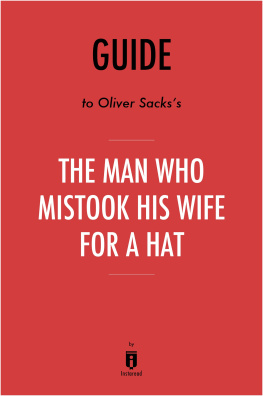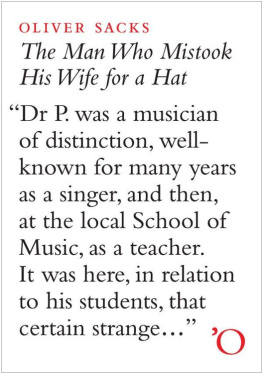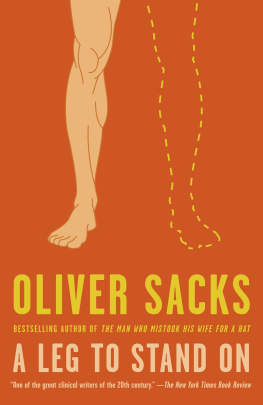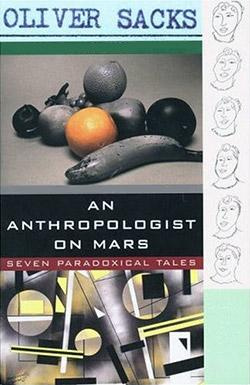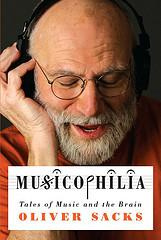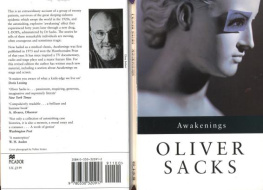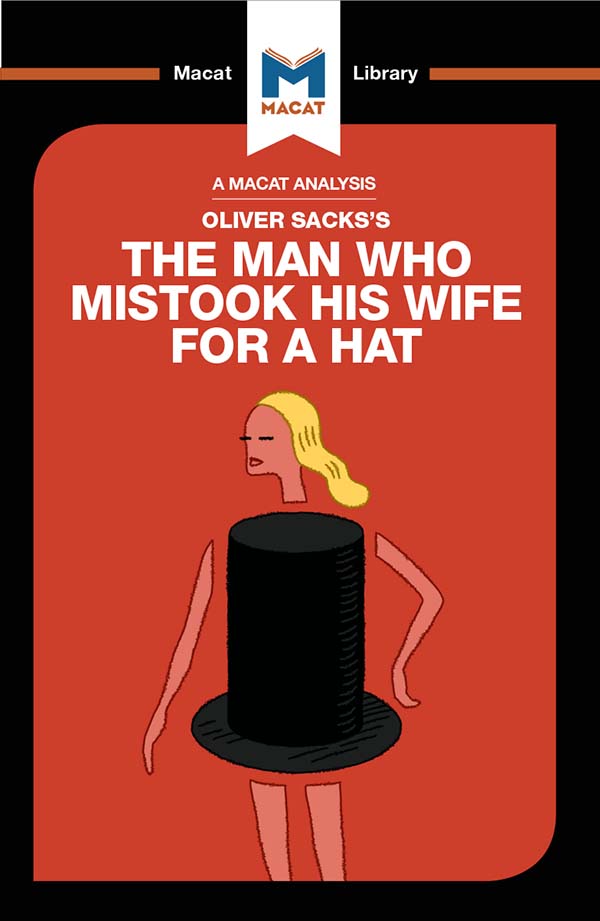Contents

An Analysis of
Oliver Sackss
The Man Who Mistook His Wife for a Hat and Other Clinical Tales
Dario. Krpan

Copyright 2017 by Macat International Ltd
24:13 Coda Centre, 189 Munster Road, London SW6 6AW.
Macat International has asserted its right under the Copyright, Designs and Patents Act 1988 to be identified as the copyright holder of this work.
The print publication is protected by copyright. Prior to any prohibited reproduction, storage in a retrieval system, distribution or transmission in any form or by any means, electronic, mechanical, recording or otherwise, permission should be obtained from the publisher or where applicable a license permitting restricted copying in the United Kingdom should be obtained from the Copyright Licensing Agency Ltd, Barnards Inn, 86 Fetter Lane, London EC4A 1EN, UK.
The ePublication is protected by copyright and must not be copied, reproduced, transferred, distributed, leased, licensed or publicly performed or used in any way except as specifically permitted in writing by the publishers, as allowed under the terms and conditions under which it was purchased, or as strictly permitted by applicable copyright law. Any unauthorised distribution or use of this text may be a direct infringement of the authors and the publishers rights and those responsible may be liable in law accordingly.
www.macat.com
info@macat.com
Cover illustration: Martin Ross
Cataloguing in Publication Data
A catalogue record for this book is available from the British Library.
ISBN 978-1-912303-66-3 (hardback)
ISBN 978-1-912128-46-4 (paperback)
ISBN 978-1-912282-54-8 (e-book)
Notice
The information in this book is designed to orientate readers of the work under analysis, to elucidate and contextualise its key ideas and themes, and to aid in the development of critical thinking skills. It is not meant to be used, nor should it be used, as a substitute for original thinking or in place of original writing or research. References and notes are provided for informational purposes and their presence does not constitute endorsement of the information or opinions therein. This book is presented solely for educational purposes. It is sold on the understanding that the publisher is not engaged to provide any scholarly advice. The publisher has made every effort to ensure that this book is accurate and up-to-date, but makes no warranties or representations with regard to the completeness or reliability of the information it contains. The information and the opinions provided herein are not guaranteed or warranted to produce particular results and may not be suitable for students of every ability. The publisher shall not be liable for any loss, damage or disruption arising from any errors or omissions, or from the use of this book, including, but not limited to, special, incidental, consequential or other damages caused, or alleged to have been caused, directly or indirectly, by the information contained within.
The Macat Library
The Macat Library is a series of unique academic explorations of seminal works in the humanities and social sciences books and papers that have had a significant and widely recognised impact on their disciplines. It has been created to serve as much more than just a summary of what lies between the covers of a great book. It illuminates and explores the influences on, ideas of, and impact of that book. Our goal is to offer a learning resource that encourages critical thinking and fosters a better, deeper understanding of important ideas.
Each publication is divided into three Sections: Influences, Ideas, and Impact. Each Section has four Modules. These explore every important facet of the work, and the responses to it.
This Section-Module structure makes a Macat Library book easy to use, but it has another important feature. Because each Macat book is written to the same format, it is possible (and encouraged!) to cross-reference multiple Macat books along the same lines of inquiry or research. This allows the reader to open up interesting interdisciplinary pathways.
To further aid your reading, lists of glossary terms and people mentioned are included at the end of this book (these are indicated by an asterisk [*] throughout) as well as a list of works cited.
Macat has worked with the University of Cambridge to identify the elements of critical thinking and understand the ways in which six different skills combine to enable effective thinking.
Three allow us to fully understand a problem; three more give us the tools to solve it. Together, these six skills make up the PACIER model of critical thinking. They are:
ANALYSIS understanding how an argument is built
EVALUATION exploring the strengths and weaknesses of an argument
INTERPRETATION understanding issues of meaning
CREATIVE THINKING coming up with new ideas and fresh connections
PROBLEM-SOLVING producing strong solutions
REASONING creating strong arguments
To find out more, visit WWW.MACAT.COM.
Contents
Critical Thinking and The Man Who Mistook His Wife For A Hat
Primary critical thinking skill: CREATIVE THINKING Secondary critical thinking skill: REASONING
In The Man Who Mistook His Wife for a Hat, neurologist Oliver Sacks looked at the cutting-edge work taking place in his field, and decided that much of it was not fit for purpose. Sacks found it hard to understand why most doctors adopted a mechanical and impersonal approach to their patients, and opened his mind to new ways to treat people with neurological disorders. He explored the question of deciding what such new ways might be by deploying his formidable creative thinking skills. Sacks felt the issues at the heart of patient care needed redefining, because the way they were being dealt with hurt not only patients, but practitioners too. They limited a physicians capacity to understand and then treat a patients condition. To highlight the issue, Sacks wrote the stories of 24 patients and their neurological clinical conditions. In the process, he rebelled against traditional methodology by focusing on his patients subjective experiences. Sacks did not only write about his patients in original ways he attempt to come up with creative ways of treating them as well. At root, his method was to try to help each person individually, with the core aim of finding meaning and a sense of identity despite, or even thanks to, the patients condition. Sacks thus redefined the issue of neurological work in a new way, and his ideas were so influential that they heralded the arrival of a broader movement narrative medicine that placed stronger emphasis on listening to and incorporating patients experiences and insights into their care.
ABOUT THE AUTHOR OF THE ORIGINAL WORK
Oliver Sacks was born in Cricklewood, London in 1933. He left the United Kingdom at age 27 after receiving his medical degree from Oxford, and moved to California. There he engaged in what he called staggering bouts of pharmacological experimentation, chiefly with hallucinogenic drugs, and this would influence his later writing about neurological states. Sacks relocated to New York City in the mid-1960s and began a long association with New York University. His second book,


